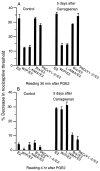Chronic hypersensitivity for inflammatory nociceptor sensitization mediated by the epsilon isozyme of protein kinase C
- PMID: 10844037
- PMCID: PMC6772473
- DOI: 10.1523/JNEUROSCI.20-12-04680.2000
Chronic hypersensitivity for inflammatory nociceptor sensitization mediated by the epsilon isozyme of protein kinase C
Abstract
We have identified a mechanism, mediated by the epsilon isozyme of protein kinase C (PKCepsilon) in peripheral neurons, which may have a role in chronic inflammatory pain. Acute inflammation, produced by carrageenan injection in the rat hindpaw, produced mechanical hyperalgesia that resolved by 72 hr. However, for up to 3 weeks after carrageenan, injection of the inflammatory mediators prostaglandin E(2) or 5-hydroxytryptamine or of an adenosine A(2) agonist into the same site induced a markedly prolonged hyperalgesia (>24 hr compared with 5 hr or less in control rats not pretreated with carrageenan). A nonselective inhibitor of several PKC isozymes and a selective PKCepsilon inhibitor antagonized this prolonged hyperalgesic response equally. Acute carrageenan hyperalgesia could be inhibited by PKA or PKG antagonists. However, these antagonists did not inhibit development of the hypersensitivity to inflammatory mediators. Our findings indicate that different second messenger pathways underlie acute and prolonged inflammatory pain.
Figures





References
-
- Aley KO, Khasar SG, Levine JD. Multiple second messenger systems act sequentially to mediate rolipram-induced prolongation of prostaglandin E2-induced mechanical hyperalgesia in the rat. Neuroscience. 1995;64:769–776. - PubMed
-
- Baranauskas G, Nistri A. Sensitization of pain pathways in the spinal cord: cellular mechanisms. Prog Neurobiol. 1998;54:349–365. - PubMed
-
- Black JA, Langworthy K, Hinson AW, Dib-Hajj SD, Waxman SG. NGF has opposing effects on Na+ channel III and SNS gene expression in spinal sensory neurons. NeuroReport. 1997;8:2331–2335. - PubMed
-
- Cesare P, McNaughton P. Peripheral pain mechanisms. Curr Opin Neurobiol. 1997;7:493–499. - PubMed
Publication types
MeSH terms
Substances
Grants and funding
LinkOut - more resources
Full Text Sources
Other Literature Sources
Medical
